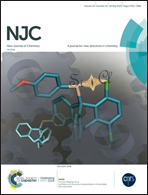Amorphous MoS2 decorated on uniform Cd0.8Zn0.2S microspheres with dramatically improved photocatalytic hydrogen evolution performance†
Abstract
A series of Cd1−xZnxS solid solutions and samples of amorphous MoS2 decorated on Cd1−xZnxS microspheres were successfully prepared. The crystal phases, morphologies, elemental distribution, chemical compositions, optical properties, and specific surface areas of the as-fabricated samples were investigated by the corresponding measurement techniques. The photocatalytic H2 evolution activities of the MoS2/Cd1−xZnxS composites were explored and compared using lactic acid as a sacrificial reagent. The results manifested that 5 wt% MoS2 loaded on the surface of the Cd0.8Zn0.2S solid solution could attain the highest photocatalytic H2 evolution rate of 12.39 mmol g−1 h−1, corresponding to an apparent quantum efficiency (AQE) of about 16.5% under 420 nm monochromatic light. The electrochemical impedance spectroscopy (EIS), transient photocurrent response and photoluminescence (PL) spectroscopy experiments confirmed that MoS2 as a cocatalyst could promote the transfer and separation of photogenerated charge carriers on the Cd0.8Zn0.2S solid solution. In addition, amorphous MoS2 decorated on the Cd0.8Zn0.2S sample showed a much better performance than that of crystalline MoS2. This could be because amorphous MoS2 possessed more abundant active sites than its crystalline counterpart. Based on the energy band positions of Cd0.8Zn0.2S and MoS2, a tentative mechanism for the enhanced photocatalytic H2 evolution activity was proposed.



 Please wait while we load your content...
Please wait while we load your content...